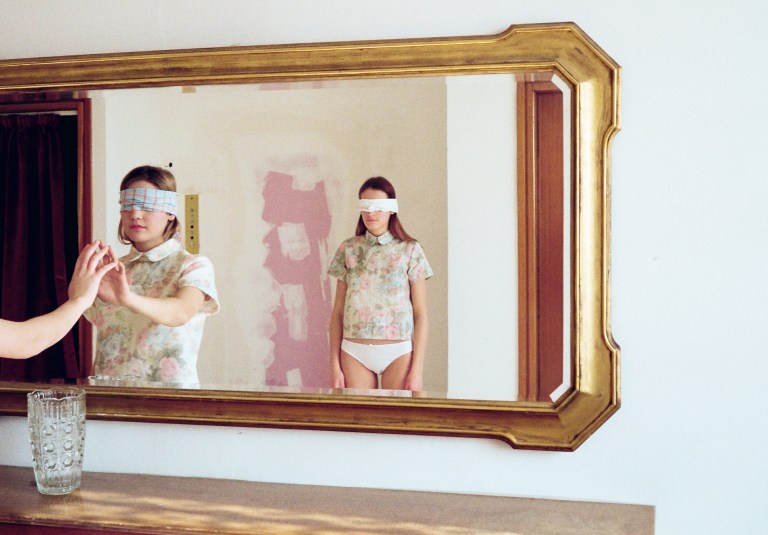Bound in a Nutshell: Living With Social Anxiety Disorder

One of my earliest childhood memories was when I was five. I was brought one day to see a child psychiatrist. Oh, don’t worry, I wasn’t much of a “problem child”. I just got these random bursts of nervous energy whenever I watched something exciting. I would pace around for a few minutes, clapping all the while, never consciously realizing what I was doing.
Naturally, my parents wanted to know what the hell these odd episodes meant, so it was off to see another doctor. I don’t remember much about the session, what the man’s face looked like or what we talked about. I do remember that he told my parents I was suffering from “dangerously low self-esteem”. I strongly suspect that the psychiatrist missed something when I spoke with him that day; I don’t blame him, it’s really hard to spot, and quite a few people probably aren’t aware that they have it, or know someone who does. I think that I have been suffering from a “new”, widespread mental disorder know as social anxiety disorder for most of my life.
Social Anxiety Disorder (which will be referred to as SAD for the rest of this article), is a type of anxiety disorder where a person avoids most social situations because they are irrationally afraid that they will embarrass themselves or be negatively judged by others. Even though it is a relatively “new” disorder, having been first formally studied in the 1960s by British psychiatrist John Marks, and was only acknowledged by the APA in 1980, SAD has most likely existed since the beginning of history and beyond.
It is the third most common mental illness next to alcoholism and depression; in fact, SAD has been linked to depression. We’re obviously depressed when we don’t have any close friends or have trouble with romantic relationships (I know this pain all too well, unfortunately). It currently affects anywhere from 7-13% of the population, and if not treated, can negatively affect all aspects of a person’s life.
SAD is very hard to spot; it is often confused with being introverted, which is a personality type, or shyness, which is perfectly natural in a lot of situations. Like many mental illnesses, SAD covers a broad spectrum of degrees. People can have “mild” cases which can disappear on its own, or it can be so severe to the point where it can cause many problems in a person’s day-to-day life, and requires extensive therapy and medical treatment to fix. I’m fairly certain that I’m a textbook case, but I can’t be positive until I talk to a professional. That’s another problem in itself: most people with SAD don’t seek treatment, either because they’re too scared, or because they just assume that the disorder is a permanent part of their personalities.
I’ve always been very shy; not only was I the shortest kid in class, I also grew up with leg braces, a speech impediment and asthma. It’s really hard to open up to people, especially when you’re a kid, and you’re constantly being reminded that you’re never going to be one of them; the “cool” kids. Never going to drive or be on the sports team, or be the prettiest.
I feel bad for my parents, ’cause no matter what they did, nothing could get me out of my shell. When I was in softball, I never got a single hit, so I felt bad for not contributing. When my mom put me in summer programs, it always made me feel uncomfortable. I felt guilty being around “slow” kids, or kids with autism; one boy I met when I was twelve, Shane, was born without feet! My body just moves a little slower than normal, how could I possibly relate to them?
In fact, if my friend hadn’t approached me one boring summer afternoon nineteen years ago, I wouldn’t have had a social life at all growing up. Let me tell you all about a guy named Jasmin Bihorac.
Now, Jasmin (or “Jazz” as I always called him), is very easy to describe. Take one look at him, and you’d think “athlete” or “movie star”. He was the kind of guy who could walk into a room and be the centre of attention. We were so opposite you’d think that we had grown up on different planets, even though we grew up on the same street. He was tall, handsome and athletic, I was short, fat and geeky. He wore the latest clothes and listened to hip hop and gangsta rap; I couldn’t give a rat’s ass about fashion, and I shared my parents taste in music. The only things we had in common is that we were both the first-generation Canadian kids of immigrants, and we both didn’t practice our respective religions (he was brought up Muslim; and although most of my family is pretty hard-core when it comes to religion, my dad was never the most observant Catholic). Oh, and less I forget, Jazz was a ladies man; he was introducing me to a new girl every few months. You could tell when he was getting serious with a new girl when he would start listening to love songs on the computer and Boombox.
To put our relationship in terms ’90’s kids can understand, he was the Will Smith to my Carlton. To put it in terms our parents can understand, he was the Fonz to my Richie Cunningham. To put it in terms everybody can understand, he was the Achilles to my Odysseus.
But even Jasmin, awesome as he is, still couldn’t break me out of my shell. He would bring me out to see his friends, we would watch his favorite horror movies together, he took me with him on family trips and would always drop by my house whenever he could.
For my 14th birthday, he took me to see Hulk Hogan when he was doing a book tour for his autobiography in Toronto. I remember that I felt really awkward, really uncomfortable, even when we took the train downtown by ourselves . I still remember saying the lamest thing ever to the most famous wrestler ever: “What’s up, Hulkster?”
Seriously, I had over two weeks to come up with something cool to say to the guy, and that’s the best I could come up with? There’s ten amazing seconds of my life that I’ll never get back.
There are certain risk factors every parent should look out for when it comes to SAD, and I had several of the symptoms: low self-esteem, very shy, poor grades, my dad had trouble talking to people as well, I lacked social skills, I was too emotional and I suffered through several embarrassing episodes in my childhood which I will not go into here. People with SAD are caught in a vicious cycle; they tend to always put themselves down when thinking about how they appear to others; when they come into contact with someone new, negative thoughts and a constant state of panic makes them tremble, sweat a lot, stutter, or leave their faces blank, which understandably sends some very negative signals to the other person. Bad experiences lead to more bad experiences, and unless something is done, the person with SAD will be convinced that they are just not sociable people.
So what’s a parent or adult suffering from this illness to do? There are many options available. If the problem is not too serious, a person could try some self-therapy techniques, such as visualizing a social situation, and imagining the sequence of events having a constant positive outcome during the conversation, until they are ready for real life scenarios.
If the problem is more severe, professional help and medication will be required. The most common therapeutic method is cognitive behavioral therapy (CBT), which is just a fancy way of saying that, by making the patient examine his or her thoughts before going through a social situation, they see how irrational their thoughts are and their anxiety levels go down. This works best one-on-one or in groups. There are also fringe treatments that have not been proven by research, such as hypnosis, but I wouldn’t recommend something like that.
Anti-depressant drugs such as Paxil, Zolfor and Exxor have been found to be effective against SAD as well. But there is no guarantee that the drugs will work (everybody’s biochemistry is different), and Paxil has several negative side effects.
So, if anyone reading this wonders why you can’t seem to open up and talk just like everyone around you, I want you to know that it is not a permanent part of who you are, but a problem that can and must be dealt with. And it doesn’t make you weal or weird; more people have it then you realize, even if they don’t know it or won’t admit to it.
It is not (usually) the parents fault, or the school’s fault or most importantly, your fault. It is the fault of a society that prizes the loud, flashy and bold over the quiet, careful and thoughtful, and tries to convince us everyday of our lives that this is the mold which we must fit ourselves into in order to be happy. ![]()




